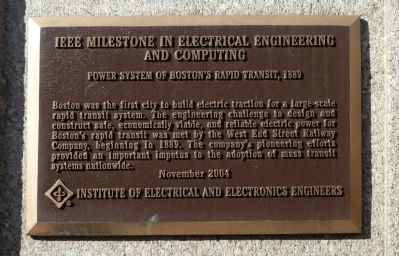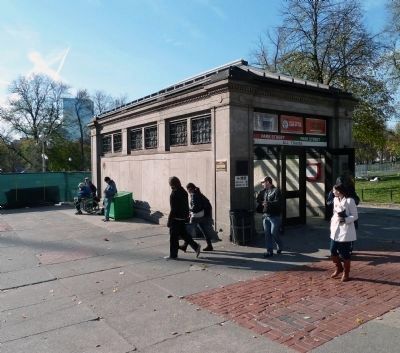Beacon Hill in Boston in Suffolk County, Massachusetts — The American Northeast (New England)
Power System of Bostonís Rapid Transit, 1889
IEEE Milestone in Electrical Engineering and Computing
Inscription.
Boston was the first city to build electric traction for a large-scale rapid transit system. The engineering challenge to design and construct safe, economically viable, and reliable electric power
for Bostonís rapid transit was met by the West End Street Railway Company, beginning in 1889.
The companyís pioneering efforts provided an important impetus to the adoption of mass transit
systems nationwide.
Erected 2004 by Institute of Electrical and Electronics Engineers.
Topics and series. This historical marker is listed in this topic list: Railroads & Streetcars. In addition, it is included in the IEEE Milestones in Electrical Engineering and Computing series list. A significant historical year for this entry is 1889.
Location. 42° 21.388′ N, 71° 3.748′ W. Marker is in Boston, Massachusetts, in Suffolk County. It is in Beacon Hill. Marker is at the intersection of Tremont Street and Park Street, on the right when traveling south on Tremont Street. Marker is at the northeastern corner of Boston Common, at one entrance to the Park Street subway station. Touch for map. Marker is in this post office area: Boston MA 02108, United States of America. Touch for directions.
Other nearby markers. At least 8 other markers are within walking distance of this marker. Tremont Street Subway (here, next to this marker); The Common / The Freedom Trail / America's First Subway (a few steps from this marker); Park Street Subway (a few steps from this marker); Boston Common (a few steps from this marker); Park Street Church (within shouting distance of this marker); Park Street Congregational Church (within shouting distance of this marker); First Commercial Dental Laboratory in America (within shouting distance of this marker); Manufactory House Site (within shouting distance of this marker). Touch for a list and map of all markers in Boston.
Regarding Power System of Bostonís Rapid Transit, 1889. Richmond, Virginia, is also credited with the worldís first successful electric railway, designed by Frank Julian Sprague in 1888. That same year, executives of Bostonís West End Street Railway went to Richmond, saw a demonstration, and placed an order with Sprague for a similar but larger system in Boston.
By 1889 Bostonians were riding their own electric streetcars, which proved far more efficient than the horse-drawn trolleys then in use. In his 2010 book, A City So Grand: The Rise of an American Metropolis, Boston 1850Ė1900, Stephen Puleo notes that Bostonís
horse population plummeted from 7,700 to 857 in just six years, and the number of electric trolleys soared to 1,714.
Concurrently, traffic congestion grew and gave the stimulus for Boston to build Americaís first subway system during 1895Ė97. West End Railway built the subwayís power system, too. So it is no coincidence to find the IEEE marker mounted on one of the main entrances to the Park Street Station.
Credits. This page was last revised on January 30, 2023. It was originally submitted on November 23, 2011, by Roger W. Sinnott of Chelmsford, Massachusetts. This page has been viewed 661 times since then and 25 times this year. Last updated on August 8, 2020, by Craig Baker of Sylmar, California. Photos: 1, 2. submitted on November 23, 2011, by Roger W. Sinnott of Chelmsford, Massachusetts. • Michael Herrick was the editor who published this page.

